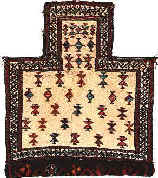|
|
Most of Baluch's namakdans are woven by Baluch of Khorasan and a few of those are woven by Baluch of Systan and Baluchistan.
In general, weaving is more common among Baluch of Khorasan, than Baluch of Southern regions, specially about piled carpets, except Zabol, which was involve in pile weaving. Piled weave is not common in other regions of Baluchistan and it has a few flat weave pieces in comparison with flat weaving of Khorasan's Baluch.
Influence of neighbors, like Kurd of Khorasan and Turkmen, on their weaving could not be denied; but despite of being influenced, their weaving have excellent role in carpet weaving of Khorasan. Purity and pleasantness of Baluch weaving make every viewer to think and admire.
Simple combination containing purified plant like images, with mostly dark and gray colors, have given depth and special meaning to their weaving. Light and sharp colors like orange, yellow, green and red are used only as spots or tiny dots. Using the combination of dark and homogeneous colors is originated from an attitude, which is called "Veil of Color", sign of humility and modesty.
Size of Baluch namakdans are average and almost the same . Most are woven by flat weave method, which is made by the combination of kilim and substitute weft.
Baluch of Khorasan have also woven a plenty of weft wrapping namakdans. Their piled weave namakdans are less than flat weave ones, in comparison. There are also namakdans, which are woven by combination of piled and flat weave.
Used material is totally wool, though sometimes a little amount of silk or cotton thread are used.
Edge of Baluch namakdans is wrapped by green, dark brown or black hair.

|
|

